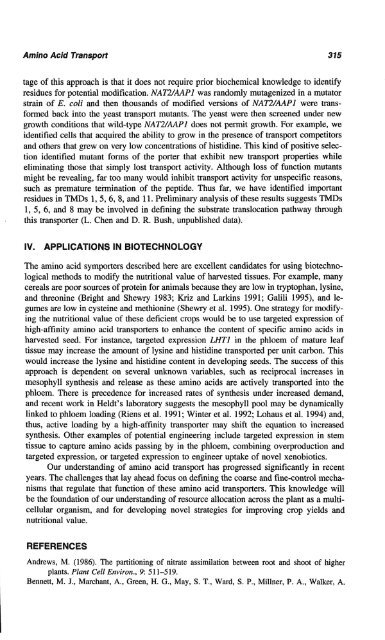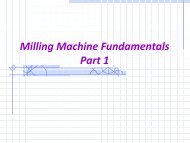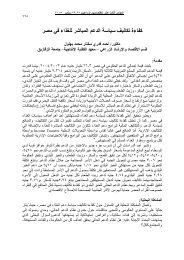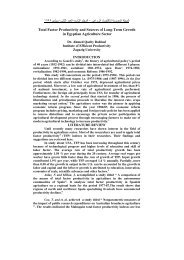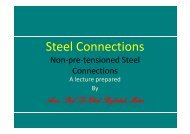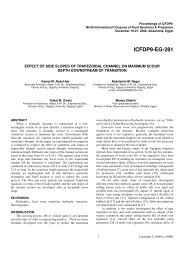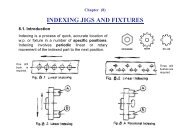Amino Acid Transport
Amino Acid Transport
Amino Acid Transport
- No tags were found...
You also want an ePaper? Increase the reach of your titles
YUMPU automatically turns print PDFs into web optimized ePapers that Google loves.
tage of this approach is that it does not require prior biochemical knowledge to identify<br />
residues for potential modification. ~ A ~ was randomly / ~ mutagenized ~ l in a mutator<br />
strain of E. coli and then thousands of modified versions of ~ A were trans- ~ /<br />
formed back into the yeast transport mutants. The yeast were then screened under new<br />
growth conditions that wild-type ~ A ~ does / not permit ~ ~ growth. l For example, we<br />
identified cells that acquired the ability to grow in the presence of transport competitors<br />
and others that grew on very low concentrations of histidine. This kind of positive selection<br />
identified mutant forms of the porter that exhibit new transport properties while<br />
eliminating those that simply lost transport activity. Although loss of function mutants<br />
might be revealing, far too many would inhibit transport activity for unspecific reasons,<br />
such as premature te~ination of the peptide. Thus far, we have identified important<br />
residues in TMDs 1,5,6,8, and 11. ~reliminary analysis of these results suggests TMDs<br />
1, 5, 6, and 8 may be involved in defining the substrate translocation pathway through<br />
this transporter (L. Chen and D. R. Bush, unpublished data).<br />
The amino acid symporters described here are excellent candidates for using biotechnological<br />
methods to modify the nutritional value of harvested tissues. For example, many<br />
cereals are poor sources of protein for animals because they are low t~ptophan, in lysine,<br />
and threonine (Bright and Shewry 1983; z and Larkins 1991 ; Galili 1995), and legumes<br />
are low in cysteine and methionine (Shewry et al. 1995). One strategy for modifying<br />
the nutrition^ value of these deficient crops would be to use targeted expression of<br />
high-affinity amino acid transporters to enhance the content of specific amino acids in<br />
harvested seed. For instance, targeted expression MTl in the phloem of mature leaf<br />
tissue may increase the amount of lysine and histidine transported per unit carbon. This<br />
would increase the lysine and histidine content in developing seeds. The success of this<br />
approach is dependent on several unknown variables, such as reciprocal increases in<br />
mesophyll synthesis and release as these amino acids are actively transported into the<br />
phloem. There is precedence for increased rates of synthesis under increased demand,<br />
and recent work in Heldt’s laboratory suggests the mesophyll pool may be dynamically<br />
linked to phloem loading (Mens et al. 1991 ; Winter et al. 1992; Lohaus et al. 1994) and,<br />
thus, active loading by a high-affinity transporter may shift the equation to increased<br />
synthesis. Other examples of potential engineering include targeted expression in stem<br />
tissue to capture amino acids passing by in the phloem, combining ove~roduction and<br />
targeted expression, or targeted expression to engineer uptake of novel xenobiotics.<br />
Our understanding of amino acid transport has progressed si~nificantly in recent<br />
years. The challenges that lay ahead focus on defining the coarse and fine-con~ol mechanisms<br />
that regulate that function of these amino acid transporters. This knowledge will<br />
be the fo~ndation of our understanding of resource allocation across the plant as a multicellular<br />
organism, and for developing novel strategies for improving crop yields and<br />
nu~tion~ value.<br />
Andrews, M. (1986). The p~itioning of nitrate assi~ilation between root and shoot of higher<br />
plants. Plant Cell Environ., 9: 511-519.<br />
Bennett, M. J., Marchant, A,, Green, . G., May, S. T., Ward, S. P., Millner, P. A., Walker, A,


